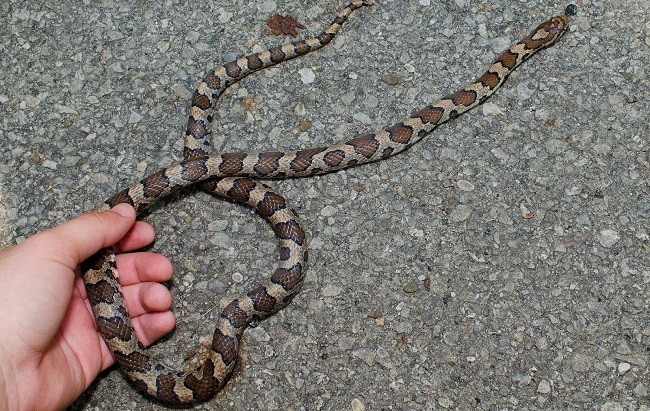Corn snakes, with their strikingly colorful scales, are a non-native yet prevalent part of Ohio’s wildlife, especially as household pets.
Although not indigenous to Ohio, the popularity of these mild-tempered creatures has led to their widespread presence in the state.
This comprehensive article delves into the world of Corn Snakes in Ohio, discussing their behavior, habitat, and care requirements, along with their influence on the local ecosystem.

Corn Snakes: A Brief Overview
Corn snakes (Pantherophis guttatus) are medium-sized reptiles, known for their docility and vibrant, corn kernel-like coloration, a characteristic that gives them their name.
Read Also:
Originally native to the southeastern United States, these snakes have spread across various regions, including Ohio, largely due to the pet trade.
Corn Snakes as Pets in Ohio
The corn snake’s manageable size, striking appearance, and generally docile nature make it a popular choice among Ohio’s reptile enthusiasts.
These snakes thrive in warm, dry environments that mimic their natural habitat, and can be comfortably housed in terrariums with plenty of hiding spots.
They primarily feed on small rodents, making them relatively easy to cater to. In Ohio, they can be legally kept as pets without a special permit.
Corn Snakes in Ohio’s Wild
Despite their non-indigenous status, corn snakes have been occasionally spotted in the wild across Ohio, attributed to escaped or intentionally released pets.
However, Ohio’s colder winter climate is not an ideal environment for corn snakes, which prefer the warmer temperatures of their native southeastern habitats.
Implications for Ohio’s Ecosystem
The appearance of Corn Snakes in Ohio’s wild can have significant implications for the local ecosystem. As predators of small rodents, their presence may impact local fauna.
Additionally, they can fall prey to local predators or suffer during harsh winters. Therefore, pet owners are strongly urged to avoid releasing corn snakes into the wild.
Conservation Measures
In response to the presence of corn snakes and other non-native species, organizations like the Ohio Department of Natural Resources have put forth efforts to maintain ecological balance. While corn snakes are not classified as endangered, their well-being, along with the health of Ohio’s local wildlife, is a priority.
The Corn Snake’s Native Range and Its Spread to Ohio
Corn snakes are originally from the southeastern United States, including states like Florida, Georgia, and South Carolina.
These regions offer warm and temperate climates that are ideal for corn snakes. However, due to their popularity in the pet trade, these snakes have spread to non-native areas, including Ohio.
Being excellent escape artists, it’s not unusual for pet corn snakes to find their way into the wild, especially in areas where they’re popular as pets. This is likely the case in Ohio, where escaped or released pets have established a non-native presence.
Adapting to Ohio’s Climate
Ohio’s climate is not naturally suited for corn snakes, with its harsh winters posing a significant challenge. Corn snakes are ectothermic, which means they rely on their environment to regulate body temperature.
While they can adapt to a range of temperatures, they thrive in a warm and dry climate. Nevertheless, it seems that some corn snakes have managed to survive Ohio’s varying climate, likely finding ways to seek warmth during colder months, such as burrowing underground or seeking refuge in human-made structures.
However, their survival rate in the wild is significantly lower than in their native range due to the less favorable climatic conditions.
Responsible Pet Ownership
With the presence of Corn Snakes in Ohio largely attributed to the pet trade, responsible pet ownership becomes an essential topic. People who keep Corn Snakes in Ohio should understand the importance of secure housing to prevent escapes.
Additionally, unwanted or unmanageable pets should not be released into the wild. Instead, owners should reach out to local animal rescues, pet shops, or herpetological societies that can assist in finding suitable homes or care for these creatures.
Read Also:
Conclusion
The presence of Corn Snakes in Ohio paints an interesting picture of how pet trade can influence local ecosystems. Whether as intriguing pets or occasional wild sightings, corn snakes have undeniably found a place in Ohio’s wildlife tapestry.
Ensuring their responsible care and preventing their uncontrolled release into the wild is crucial for the health of these vibrant reptiles and the preservation of Ohio’s diverse ecosystems.
























